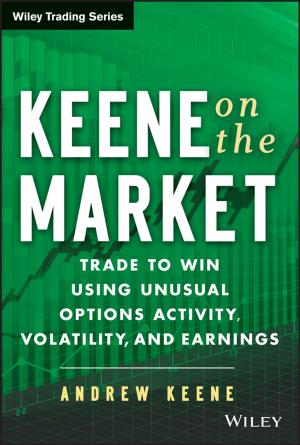| Author: | Mark D Wolfinger | ISBN: | 9781310372582 |
| Publisher: | Mark D Wolfinger | Publication: | July 28, 2014 |
| Imprint: | Smashwords Edition | Language: | English |
| Author: | Mark D Wolfinger |
| ISBN: | 9781310372582 |
| Publisher: | Mark D Wolfinger |
| Publication: | July 28, 2014 |
| Imprint: | Smashwords Edition |
| Language: | English |
Iron Condors is the third book in the "Best Option Strategies" series and each offers a hands-on education for some of the most useful option strategies. It is intended to be very different from all other books about iron condors.
Expect to learn the basic concepts of trading iron condors: (1) How to decide which options are suitable for your iron condor. Know in advance that there is seldom a single ‘best’ position that suits all traders; (2) Ideas -- with specific examples -- on how to manage risk; (3) Figuring out when to exit. We’ll discuss the pros and cons of locking in profits quickly (not a good idea) vs. holding longer (but not too long).
There is more that makes this book so special. It is not just a “how to” book because I share lessons learned from a lifetime of trading options (starting in 1977 when I became a CBOE market maker). I share my philosophy on iron condor trading and ideas on how a winning trader thinks. The goal is to offer guidance that allows you to develop good trade habits and an intelligent way of thinking about trading. We all learn as we gain experience, but some experience can be destructive when mindsets -- that are dangerous to your longevity as a trader -- become ingrained habits. This book helps traders avoid developing a difficult-to-break way of thinking.
This book was prepared for an audience that already understands the most basic concepts about options. Although some of the material is suitable for rookies. If you do not understand the difference between a put and call or have zero trading experience, I encourage you to begin with the most basic concepts about options before continuing. There are numerous sources of information, but I recommend my recently updated (2013) The Rookie’s Guide to Options, 2nd edition.
Another decision involves the pre-planned (I encourage preparation of a trade plan for each trade) exit when the target profit is achieved. If you have no profit target, then you will be hard pressed to exit when the trade continues to earn money. As profits accumulate, it becomes a daily decision: hold or exit. It is important to recognize when there is too little remaining profit potential for the prudent trader to hold. The trade plan helps with making good and timely decisions -- and that makes you a more disciplined trader.
Closing the position could also be a gut-wrenching decision that locks in a loss and is made because it has become essential to take risk-reducing action. The book offers a solid introduction to risk management for iron condor traders.
The following points represent the foundation of my beliefs, and the book is written accordingly: (1)The ability to manage risk is the most important skill for any trader; (2) Take time to learn about the Greeks. It is not difficult, and it allows you to recognize the risk (and reward) potential for any position; (3) Discipline is necessary when managing risk. It is one thing to say that you understand what risk management is all about, but it is another to put it into practice; (4) Let another trader earn the last nickel or dime on the call and put spreads that comprise the iron condor. Pay a small sum to exit, lock in profits, and eliminate all risk.
The iron condor is most often traded as a single transaction, consisting of four legs. However, it is managed as if it were two positions. This is not a contradiction. This mindset is covered in detail
Iron Condors is the third book in the "Best Option Strategies" series and each offers a hands-on education for some of the most useful option strategies. It is intended to be very different from all other books about iron condors.
Expect to learn the basic concepts of trading iron condors: (1) How to decide which options are suitable for your iron condor. Know in advance that there is seldom a single ‘best’ position that suits all traders; (2) Ideas -- with specific examples -- on how to manage risk; (3) Figuring out when to exit. We’ll discuss the pros and cons of locking in profits quickly (not a good idea) vs. holding longer (but not too long).
There is more that makes this book so special. It is not just a “how to” book because I share lessons learned from a lifetime of trading options (starting in 1977 when I became a CBOE market maker). I share my philosophy on iron condor trading and ideas on how a winning trader thinks. The goal is to offer guidance that allows you to develop good trade habits and an intelligent way of thinking about trading. We all learn as we gain experience, but some experience can be destructive when mindsets -- that are dangerous to your longevity as a trader -- become ingrained habits. This book helps traders avoid developing a difficult-to-break way of thinking.
This book was prepared for an audience that already understands the most basic concepts about options. Although some of the material is suitable for rookies. If you do not understand the difference between a put and call or have zero trading experience, I encourage you to begin with the most basic concepts about options before continuing. There are numerous sources of information, but I recommend my recently updated (2013) The Rookie’s Guide to Options, 2nd edition.
Another decision involves the pre-planned (I encourage preparation of a trade plan for each trade) exit when the target profit is achieved. If you have no profit target, then you will be hard pressed to exit when the trade continues to earn money. As profits accumulate, it becomes a daily decision: hold or exit. It is important to recognize when there is too little remaining profit potential for the prudent trader to hold. The trade plan helps with making good and timely decisions -- and that makes you a more disciplined trader.
Closing the position could also be a gut-wrenching decision that locks in a loss and is made because it has become essential to take risk-reducing action. The book offers a solid introduction to risk management for iron condor traders.
The following points represent the foundation of my beliefs, and the book is written accordingly: (1)The ability to manage risk is the most important skill for any trader; (2) Take time to learn about the Greeks. It is not difficult, and it allows you to recognize the risk (and reward) potential for any position; (3) Discipline is necessary when managing risk. It is one thing to say that you understand what risk management is all about, but it is another to put it into practice; (4) Let another trader earn the last nickel or dime on the call and put spreads that comprise the iron condor. Pay a small sum to exit, lock in profits, and eliminate all risk.
The iron condor is most often traded as a single transaction, consisting of four legs. However, it is managed as if it were two positions. This is not a contradiction. This mindset is covered in detail















